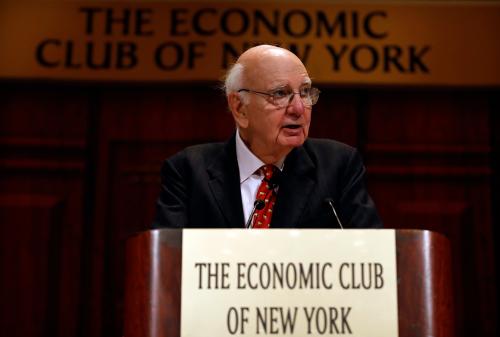Kohn delivered these remarks at the Shadow Open Market Committee (SOMC) Meeting: Current Monetary Policy: The Influence of Marvin Goodfriend. Goodfriend was a professor at the Carnegie Mellon University and before that an economist at the Federal Reserve Bank of Richmond for many years.
I very much appreciate the opportunity to participate in this conference. Marvin and I interacted often as we both served in the Federal Reserve System, comparing notes on developments in macroeconomics and monetary policy at numerous conferences and in informal contacts along the margins of FOMC meetings and elsewhere.
We didn’t always agree of course. In fact, conference organizers liked to position Marvin and me as the pro and con on explicit inflation targeting. These were great learning opportunities for me. Marvin marshalled empirical evidence and embedded that evidence in the theory and practice of central banking over history. Marvin was open and honest about his views and the supporting evidence. And, however much you might have differed, you couldn’t doubt his focus on and devotion to bringing his considerable intelligence and deep learning to serving the interests of the Federal Reserve and the United States. I always enjoyed those interchanges.
In the end Marvin’s analysis prevailed. In the aftermath of the financial crisis I was won over to the view that the benefits of an explicit inflation target would exceed its costs and the Fed adopted a two percent target in 2012.
I will take a few minutes to reflect on the communication piece of the Fed’s discussion of policy in a low-rate environment, putting forward a wish list of what I hope comes out of the process.
But the essence of Marvin’s vision has been realized. The Federal Reserve has made an explicit public commitment to achieving two percent inflation over time, reinforcing its implicit target, and it has framed its ongoing discussion of policy strategy, tools and communication around that commitment. The rationale for those shifts was only indirectly related to Marvin’s argument that the target and associated commitment were required as a bulwark against high inflation and the inflation scares of his research. Rather, my conversion and the explicit target emerged from the threat of the Federal Reserve missing both its employment and inflation targets on the low side. I saw an explicit target as helping gain support for additional monetary policy action from the members of the FOMC who, like Marvin, feared that unconventional policies might cause much higher inflation down the road. And the target was adopted when the major risk was that inflation expectations would fall below two percent, limiting the scope for policy easing in the future.
That discussion of policy in a low-rate environment has already seen advances in Fed openness that would please Marvin. It has announced the process and held Fed Listens sessions to get input from the public and from academics; it has reported on the progress of its deliberations in the minutes of the FOMC; and a few members of the FOMC have kept us informed about the evolution of their thinking. Since this is a panel on transparency, I will take a few minutes to reflect on the communication piece of the Fed’s discussion, putting forward a wish list of what I hope comes out of the process.
1. Clarity about strategy
By clarity of strategy, I do not mean necessarily adopting a hard rule for making up misses from two percent—say with a price level target or averaging over a defined period of time—or following an interest rate rule of some sort to get there. Those are decisions on strategy, not communications.
But I do think communications should give us clarity about whatever approach is adopted—where are the hard lines and where is the fuzziness and why the approach is expected to produce the appropriate outcomes. The effectiveness of any strategy—especially at or near the Effective Lower Bound for interest rates—is enhanced when financial market participants and other economic agents can understand the strategy and can anticipate the deployment of tools—the path of interest rates and the use of unconventional policies, like enhanced forward guidance and asset purchases.
We don’t have that clarity now. For example, the FOMC describes its inflation target as symmetrical, but never defines “symmetry” and I have the clear sense that it means different things to different policymakers. In addition, transparent explanations of policy would relate meeting-to-meeting decisions to the longer-term strategy. Over recent years, the strategy statement has been reissued every January then not referenced as decisions are made and explained.
I recognize that consensus on a large and diverse committee sometimes entails a bit of fudging on the exact meaning of the words used. But fudging has costs as well as benefits, and I hope the current round of discussion produces a statement of strategy that is clearly defined and agreed by all the participants and utilized by them as they explain their decisions to the public. That would be effective communication.
2. Clarity about tools
The use of the unconventional tools of enhanced forward guidance and asset purchases was new during the crisis and slow recovery. And, from the experience of the Fed and other central banks, we have all learned quite a bit about their effects and how they can best be deployed to maximize their effectiveness.
The exact utilization of the tools to implement strategy when policy is next near the ELB will depend on circumstances. But to the extent economic agents can accurately forecast their use, policy will be more effective, with shorter lags and less uncertainty.
The FOMC should tell us what lessons they have drawn from their experience and research and how they are most likely to shape forward guidance and asset purchases when they need to. What order are they likely to be deployed? Have they ruled out certain unconventional policies like negative interest rates and discount window incentives to lend? If so, why?
3. Clarity about risks and uncertainty
This subject is perhaps a bit oxymoronic on the surface—how can you have clarity about risks around the central forecast, and, especially about uncertainty in the Knightian sense, where you can’t even assign probabilities. Still, I’d mark the Fed with a “needs improvement” in communicating on both fronts.
For example, FOMC projections released after each include ranges of the projections and a median, but no sense of the wide range of possibilities that surround that median. The median itself can be easily moved by one or two changes in forecasts, so doesn’t really give a robust sense of the central tendency of the Committee, and it gives a false sense of certainty about the FOMC’s expectations about the course of those variables, especially the federal funds rate. Still, it seems to be a focus for the markets and even on occasion the Fed as it explains its policy stance. When those forecasts are released with the minutes, they are accompanied by a measure of forecast error by private forecasters. I recognize that finding the appropriate measure of risks and uncertainty is hard when the FOMC itself doesn’t have a forecast. But some way needs to be found to put that median in perspective, and frankly, take some attention away from it.
I also find that under some circumstances speeches about monetary policy fail to acknowledge risk and uncertainty, including our lack of understanding about economic relationships and hence about the likely course of policy. I reflect on 2018 when too many speeches and interviews, especially by Reserve Bank presidents, focused on how many increases in the federal funds rate would be appropriate going forward through 2019. As economists and policymakers, we are lucky to get the direction of rates right, and often don’t, as in this example for FOMC participants.
True transparency acknowledges our limited understanding of underlying economic relationships and of the forces bearing on the outlook. Policymakers have an obligation to discuss their understanding and expectation about these relationships and forces, but they must be humble about what they know and transparent about the high likelihood of alternative outcomes.
4. Expanding the audience
The effectiveness of policy and support for the institution in a democratic society depend on broad understanding of what the Fed is doing and why. The Federal Reserve has made good strides of late in reaching out beyond its normal constituencies of financial market participants, academics, and business people. Chairman Powell has done a god job in translating Fed speak to a wider audience. And the Fed Listens sessions have reached some new groups.
Progress has been made, but especially when the institution is under attack from the president, support in public and the Congress is key to maintaining its independence to implement policies. My recommendation here is to build on what has already been started—helping more audiences to understand how Fed actions promote the national interest as embodied in its legislative objectives.
One example I’ve experienced in this regard is at the Bank of England, where every inflation report, every financial stability report comes in three layers: a top layer of three or so key take-aways—one sentence apiece with illustrations, all suitable for tweeting—from the report and associated policy action; a second layer giving backup for the first layer with a few key graphs and explanations aimed at the press; and the report itself filled with graphs, boxes and technical explanations for the cognoscenti.
5. Rollout of the decisions on strategy, tools, and communication
The roll out of whatever comes out of the Fed’s deliberations on the challenges of policy in a low rate world will be an opportunity to underline the Federal Reserve’s commitment to a high level of transparency. Here are my recommendations:
- A white paper fully explaining the decisions, why they were taken, how they were based on experience and research, what was rejected and why, how they are expected to play out. The staff memos to the FOMC should be in an appendix so we can have a better sight into one key input into the decisions—memos that will be public in five years. Consistent with my previous recommendation, the white paper should be fronted by a short, easily comprehended, explanation of the conclusions of the study and their relationship to the Fed’s dual mandate.
- A press conference—separate from the regular monetary policy press conference—shortly after the paper is published.
- An opportunity for Congressional scrutiny of the decisions. This is consistent with the recommendation Marvin made for a Congressional hearing on the two percent target.
- A conference to bookend the Fed Listens conferences to get reactions from a variety of audiences, including some of the academics who gave papers at the conference last June.
The Brookings Institution is committed to quality, independence, and impact.
We are supported by a diverse array of funders. In line with our values and policies, each Brookings publication represents the sole views of its author(s).






Commentary
A wish list for the Fed’s communications about policy in a low-rate world
March 6, 2020